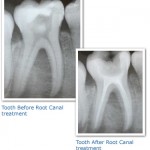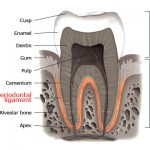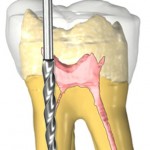A root canal treatment (RCT) is a procedure whereby the pulp of the tooth is extirpated, and filled with suitable filling materials to replace the pulp. It is also known as endodontic therapy, and the sole purpose for endodontic therapy is to remove all the inflamed and necrotic tissues in the pulp, as well as the bacterial component, making the pulp and the root canals of the tooth as clean as possible.
How does the dentist make the pulp and the root canals of the tooth clean?
This procedure is also known as cleaning and shaping. It is done after the dentist has drilled a hole in the tooth, and expose the innermost layer of the tooth – the pulp. There are two components in cleaning and shaping – the mechanical part and the chemical part.
The mechanical part is when a file is introduced into the root canals with gradual increase of the file sizes. These files have cutting edges and they will cut away some part of the dentine surrounding around  the root canal. This slowly enlarges the root canal so that irrigation material can be introduced into the canals to flush out the necrotic materials and the bacteria, and also to allow the restorative material to be placed into the canals. Cleaning and shaping has to be done till the apex, which is at the end of the canals. Whether the file have reached the apex or not can be determined using an apex locator or by taking a radiograph.
The chemical part is by using a suitable irrigant to flush the canals, as stated earlier. The ideal properties of an irrigant are
- Non toxic, non carcinogenic, and biocompatible with the tooth tissue.
- Cheap, easy to use and has a long shelf life.
- Antibacterial.
- Able to dissolve necrotic tissue .
- Able to remove the smear layer created while cleaning and shaping the canals mechanically.
- Lubricates the canal for easier introduction of the files into the canals while cleaning and shaping.
Based on these properties, various solutions have been used as irrigants in endodontic therapy, which are sodium hypochlorite, chlorhexidine, iodine potassium iodide, MTAD, ethylenediamine tetra-acetic acid, saline, and calcium hydroxide. However, sodium hypochlorite 0.5% remains the most favoured irrigant among dentists as it fulfills most of the ideal properties. For optimized chemical cleaning, sodium hypochlorite can be used together with EDTA. In some cases like when the rubber dam is not able to be placed, irrigants like saline can be used to replace sodium hypochlorite.
What are the indications for root canal therapy?
- A tooth or multiple teeth that are too badly broken down and has already involved the pulp.
- Pain in the tooth that is suggestive of periradicular or pulpal diseases.
- Non vital tooth due to various reasons, such as trauma. To determine the vitality of the tooth, various tests can be carried out. Few of the usual tests are by using electronic pulp tester (EPT), hot test and cold test. Sometimes the non vital tooth will also be discoloured, which can be seen clinically.
- To realign the occlusal plane. But this reason is not a major indication for endodontic therapy as it is very invasive and sometimes unnecessary.
What are the advantages of root canal treatment?
Root canal therapy is able to retain the natural tooth instead for opting for extraction. By retaining the natural tooth, bone resorption occurs slower and also the patient will have better proprioceptive senses. Root canal therapy have very high success rate. With successful treatment, the tooth can be retained for a lifetime provided that bone level is satisfactory, and will not show any symptoms. However, there are various form of root canal morphology, especially in the second and third molars. Sometimes a canal will be missed or there will be inadequate cleaning and shaping. In these cases, reinfection can occur, and an endodontic re-treatment will be needed.

A suitable restorative material is placed into the root canals after cleaning and shaping is completed.
Although root canal therapy is a very good treatment option, not all teeth are suitable for this treatment as some factors may lead to a poor prognosis of the tooth, such as severe loosening of the tooth, or root fractures, or patients with systemic disease that will complicate the endodontic procedure. For the posterior teeth that has underwent root canal therapy, a crown is almost always needed to protect the tooth. This is because after removal of the dentine surrounding the canals during cleaning and shaping procedure, the tooth will be weakened and become more brittle, rendering it to increased likelihood of fracture. For anterior teeth, if there has been too much loss of tooth structure, a crown will also be indicated. In certain severe cases, post and core might even be needed. Hence, the cost of the whole procedure could be costly. Therefore, it is wise to listen to the advice and opinion of the dentist who is looking at the teeth clinically, or if in doubt, get a second opinion from another dentist.

